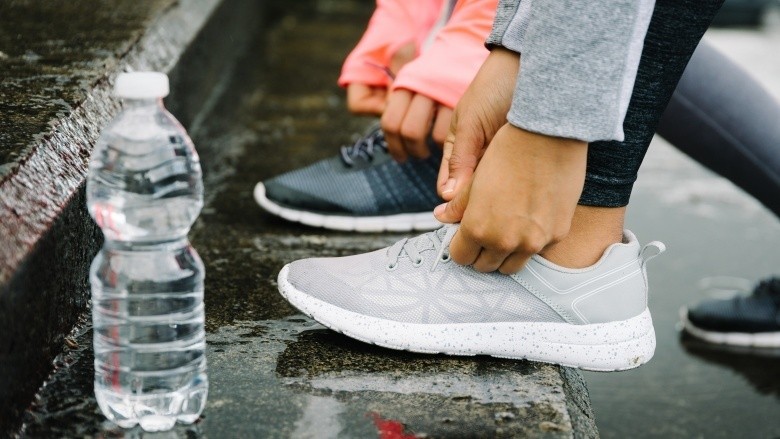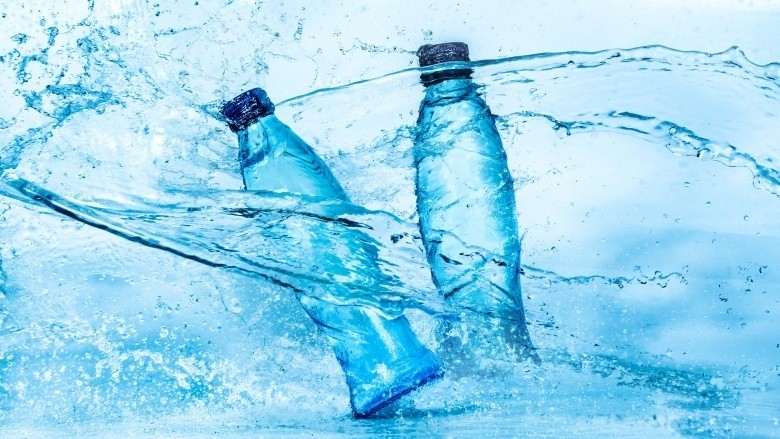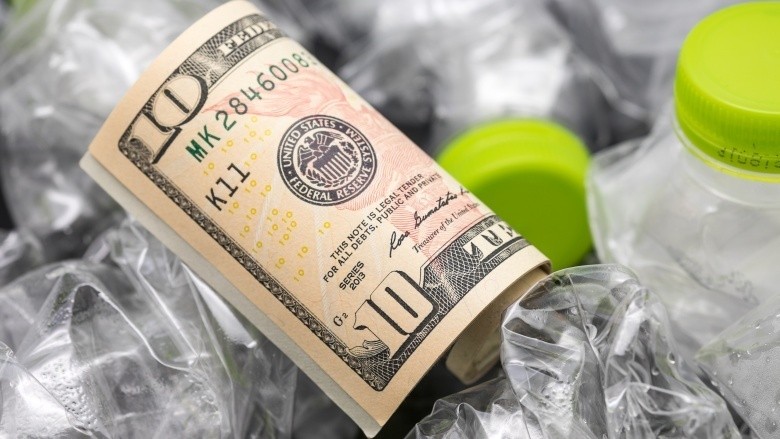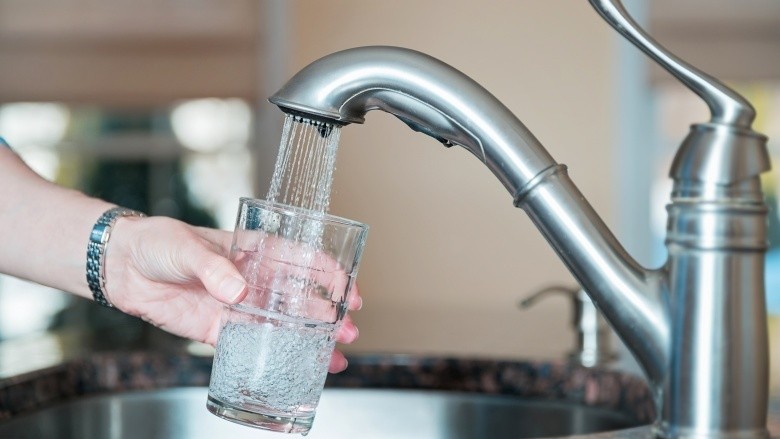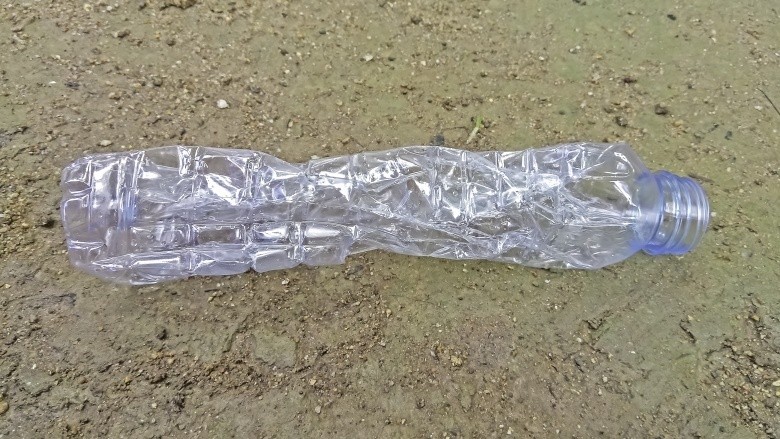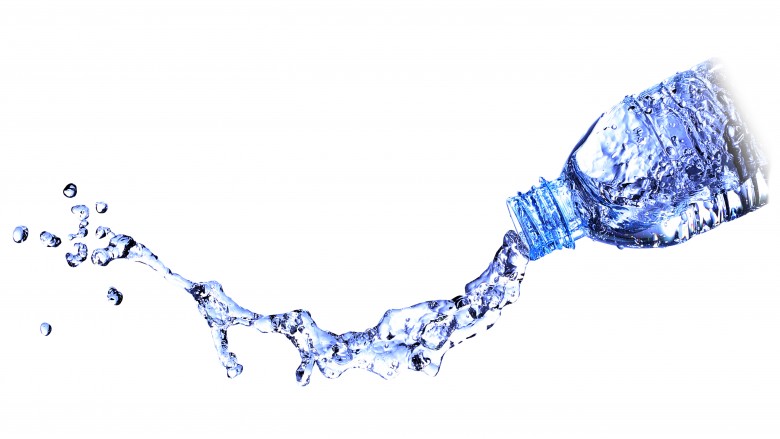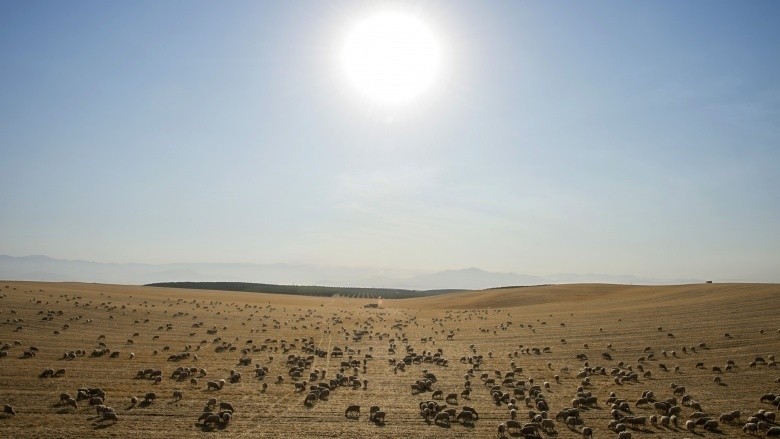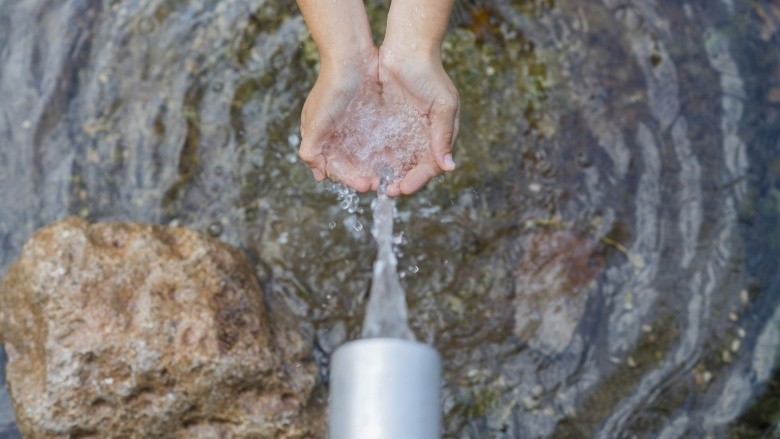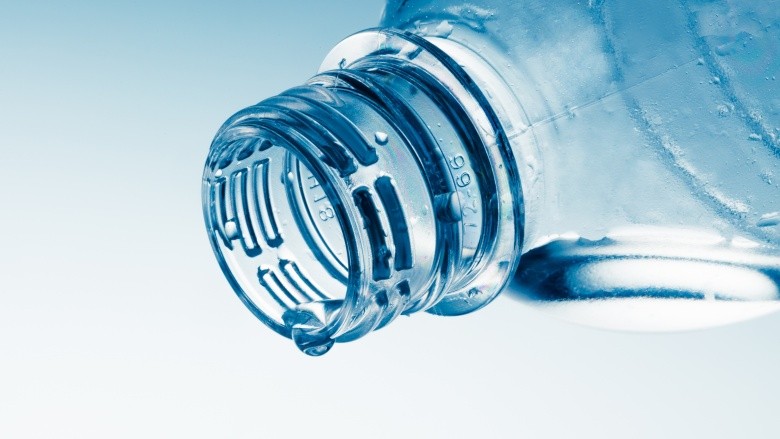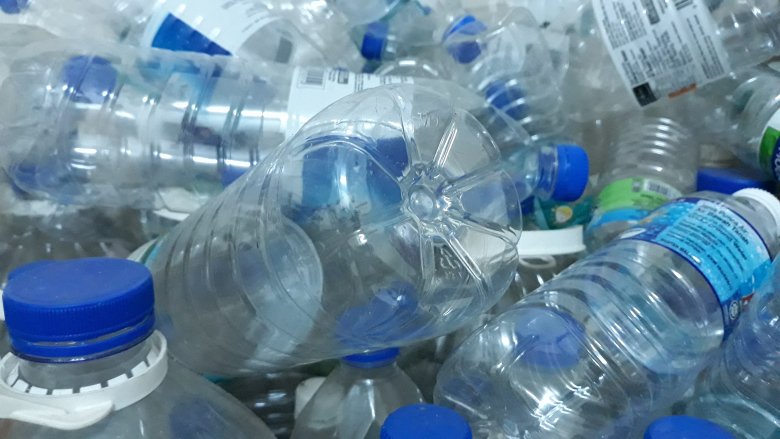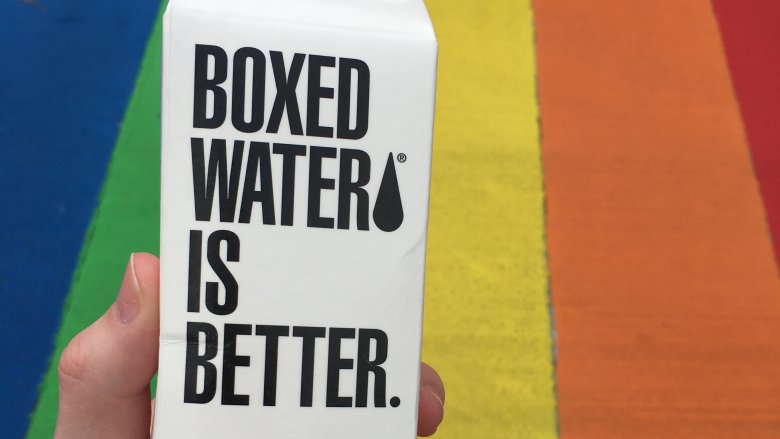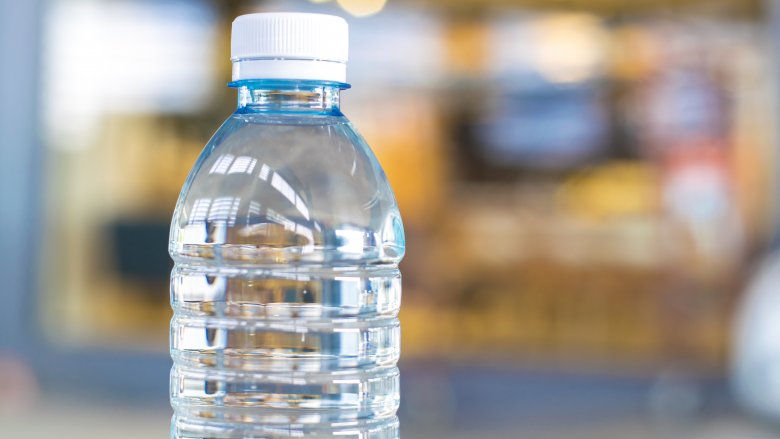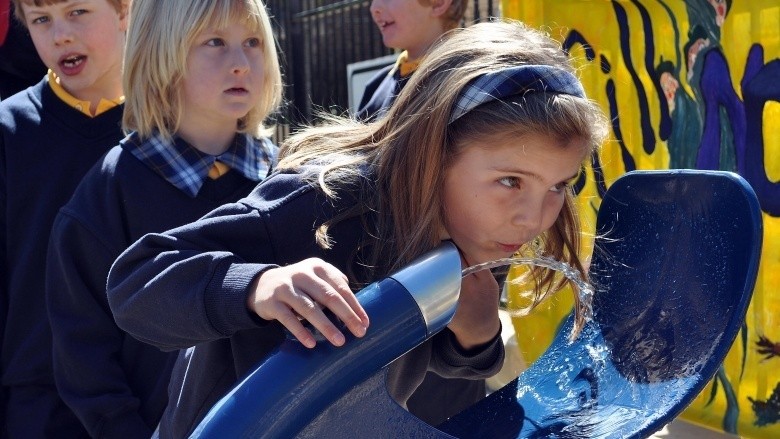The Real Reason You Should Stop Buying Bottled Water
Bottled water is a convenience most people are guilty of taking advantage of, and there's a chance yours is one of those families that always keeps a case on-hand. They're great for taking on-the-go, perfect for parties, and get rid of the need to wash a glass.
This is one convenience you should absolutely stop taking advantage of, though, as it's got some far-reaching consequences, ranging from environmental to financial. The bad definitely outweighs the good on this one. You might not even be getting everything you think you're paying for when you buy bottled water, so let's take a look at just why you should take this one off your shopping list and stick to what you've got running out of your tap.
Water usage
You've probably heard bottled water is incredibly wasteful, and most people think this refers to the bottles themselves. But have you ever asked yourself about the water use? When you pick up a liter of bottled water at the store, how much water do you think went into making it?
It's more than you think. According to the International Bottled Water Association and a 2013 survey that looked at the water use of the bottled water industry, it takes an average of 1.39 liters to make a single liter of bottled water. That extra .39 liters might not sound like a whole lot, but it adds up fast. Given that the entire market study included data from the manufacture of 14.5 million liters, that's 5.66 million liters of wasted water used in final production.
The IBWA points out their total water usage is less than other parts of the beverage industry. But two wrongs don't make a right, and some environmental groups aren't convinced the numbers are anywhere near acceptable. Ertug Ercin, spokesperson for the Water Footprint Network, says the industry's impact is even farther reaching than that. He says when you include the water that goes into making the packaging materials and bottles, you're looking at more like seven or eight times that number.
The cost
Spending a buck on a bottle of water might not seem like a huge investment, and chances are good you already know you're paying for the convenience. Maybe you forgot your own water bottle at home, or you headed out on an unplanned hike through the park. But what happens when you start really looking at the numbers?
When the ConvergEx Group started comparing the cost of bottled water to tap water, they looked at averages across the country. They found people were spending around 300 times more on bottled water than they would have spent on the same amount of tap water. Oh, and that was based on the price of buying water by the gallon. How often do you buy bottled water by the gallon? When they looked at 16.9 oz. bottles (which make up about two-thirds of the market sales), the math says you're paying around $7.50 for a gallon. Compare that to the price of gas! Then, consider this — that's almost 2,000 times the price of the same amount of water that came out of your tap. It might be more cost-effective to drive home and pick up a reusable water bottle to fill yourself.
It could just all be tap water anyway
If you're still insisting bottled water is worth the cost, consider the fact that you might just be drinking regular old tap water out of that fancy bottle anyway.
In 2007, Pepsi made a startling announcement. They were changing their labels to be more transparent about where their bottled water came from, because their Aquafina was nothing more or less than tap water. If you happened to read an Aquafina label before that, you would have seen "Bottled at the source P.W.S." That's a fancy way of saying it's bottled at a Public Water Source. It's poor labeling and shady marketing at best.
Pepsi isn't alone here. Coca-Cola's Dasani is also essentially tap water. It comes from a public water source, as do some of Nestle's bottled water products. If it's natural spring water or well water you think you're getting when you open that bottle, you might find you've been mistaken.
Plastic pollution
Now, how about this little bit of food for thought? Plastic has a life span that's thought to be around 500 years long, and that means every plastic bottle you've ever crumpled up and thrown into the garbage or recycling bin still exists, and they're piling up. In 2008, volunteers who participated in Keep America Beautiful's Great American Cleanup picked up a shocking 189 million plastic water bottles that had been discarded across the country. And considering around 200 billion water bottles have been manufactured every year since then, it's starting to look a little ridiculous.
Plastic also makes up a huge part of what's called the Great Pacific Garbage Patch, a massive area of the ocean between the US coast and Japan where the world's garbage gets caught in a sort of ocean-wide vortex. Since plastic doesn't dissolve, all those plastic water bottles that don't make it into the garbage or recycling bins end up in places like this, worn down into smaller and smaller pieces. No one's sure just how much plastic is there, but there are places where the water is little more than a cloudy soup, and some measurements have found as much as 1.9 million pieces and bits of plastic in a single square mile. Since only about 10 percent of the world's PET plastic (the stuff a water bottle is made of) actually ends up being recycled, this is a problem of epic proportions.
All the wasted water
This one is the elephant in the room, and it's a problem on such a massive scale that it's tough to wrap your head around. Let's start with a massive number. The Beverage Marketing Corporation estimated that 11.7 billion gallons of bottled water were drank in the US in 2015. That's an unthinkable amount, especially when you consider that 98 percent of the US population has access to clean, perfectly safe tap water. Then, compare that to another statistic: one in every nine people in the world doesn't have access to clean water at all. Are you feeling wasteful yet?
Droughts don't stop them
You've probably seen the news about sporadic drought conditions that have been happening lately, especially in the American West. In August 2014, California was caught in the grip of its third drought of the year, leading to massive attempts at conserving water and fines for wasting it on what were deemed non-essential projects, like watering the lawn. Even the job market took a hit, and farmers were especially hard hit with conditions that had something of a butterfly effect. One thing that didn't stop was the bottled water production of California-based companies and suddenly, all that wasted water takes on a whole new meaning, doesn't it?
At the same time other companies were laboring under water restrictions, the dozens of bottled water companies escaped scrutiny. Even though they're responsible for reporting their water use to the Department of Public Health, that information never gets back to the state agencies making the rules and regulations to help get the state through drought conditions. That's insane, especially when you consider the impact of another drought in July 2014. Eleven states reported drought conditions, peaking with an Exceptional Drought level across most of California and parts of Nevada. Meanwhile, a spokesman from Southern California's Essentia (which uses tap water) commented, "I don't see any situation going forward that would stop us from producing bottled water."
Shady business practices
A series of investigations revealed some pretty shady things about those companies bottling water during drought conditions. In 2015, California newspapers did some digging into Nestle, who has been bottling their Arrowhead water from the resources of the San Bernardino National Forests since 1894. They found not only is there no governing body keeping track of just how much water they're taking out of the forest, but there's no one looking into the possibility that they're taking so much water it's having a negative impact on the surrounding flora and fauna. They also found Nestle's permit to transport the water had expired in 1988. Since they continued to pay their yearly fee of $524, they were simply allowed to just keep doing their thing with no review or interruption.
While Nestle says they're not doing anything wrong and they're abiding by the guidelines that have worked fine for decades, park officials say with the ongoing drought conditions, more needs to be done to make sure there are no long-lasting impacts from Nestle's activities. Forest Service employees have expressed a growing concern that the unchecked and unmonitored activities could have a negative impact that starts with the forest's vegetation and spirals outward from there. One species of native fish has already disappeared from forest streams — an extinction linked to flash floods, forest fires, and possibly to the disappearance of some of the area's natural water supply.
Safety issues
Figuring out whether or not bottled water is actually a safer option than tap water is a bit of a tricky thing, and there are a whole bunch of variables. If you're living in an area that has a contaminated water supply (Flint, Michigan's water troubles come to mind), then bottled water is the way to go. But otherwise, studies are still out on the matter, and most seem to suggest opting for bottled water isn't really doing you any favors.
According to the Mayo Clinic, bottled water and tap water are pretty much governed by similar safety standards. While the FDA regulates the production of bottled water, the EPA oversees the country's tap water supply. The first regulations regarding public drinking water were made in 1974 with the Safe Drinking Water Act, and that act has been updated over the years. Gradually, the FDA adopted most of the same rules and regulations when it came to monitoring potential contaminants and levels of various chemicals like lead. Now, the two agencies go pretty much hand-in-hand with what they allow in water. The FDA considered bottled water to be something of a low-risk food, but bottling plants still need to be licensed every year. Even though they're monitored, they're not held to standards that are any different from the guidelines the EPA uses to monitor drinking water, and bottled water is allowed to have the same level of contaminants as your tap water. (Which means it's equally safe, not equally contaminated.)
Some studies have even found tap water can be better for you than bottled water. According to researchers from Glasgow University, they found some companies can store bottles of water for months before they even make it to the shelves. Factor in things like the idea that an opened bottle of water left in the fridge can very quickly become contaminated from the outside environment and suddenly, it's looking less healthy. There's also the chance of contamination from someone who picks it up and breaks the seal at the supermarket, and that all means bottled water safety isn't all it's cracked up to be.
The energy waste is shocking
In 2009, researchers from the Pacific Institute (via PhysOrg) estimated just how much energy it took to make the disposable plastic bottles used in the bottled water industry. They included everything from making the plastic and shaping it into bottles to filling the bottles, transporting the finished product, and keeping it cold — and the findings were pretty disturbing.
A single liter of bottled water took between 5.6 and 10.2 million joules of energy, and that might not mean much, so let's put it this way. That's as much as 2,000 times the amount of energy it takes to produce the same amount of water that comes out of your tap.
We'll put it another way. Around the time that information was released, the national consumption of bottled water was around 33 billion liters — and that took the equivalent of between 32 and 54 million barrels of oil to produce. Now here's a little more perspective. Fast forward a bit, and according to The Guardian, consumers were buying these bottles at a rate of 20,000 per second in 2017 — a demand largely centered around bottled water. Around 480 billion plastic bottles were sold in 2016, and that was an increase of 300 billion from when the energy consumption survey was done. Have we learned nothing?
Attempts at environmentally friendly bottled water aren't so friendly
There have been attempts at making bottled water that's better for the planet. In 2016, The New York Times reported on Just Water, a company that made their completely recyclable "bottles" out of paper sourced from trees certified by the Forest Stewardship Council. They're still only 53 percent paper, though. The rest of the bottle is mostly plastic, with small amounts of aluminum.
They're not the only ones doing it, either. A company called Boxed Water is Better is also hopping on the bandwagon of making greener alternatives, so, are they really greener? Grist says that it's complicated.
While these boxed waters are more environmentally friendly than those that are using plastics, here's the thing — they're still horribly wasteful when compared to the water that comes out of the tap in your own kitchen. They still take raw materials, lots of energy, and they're still single-use containers. Except in emergency situations (and, again, places like Flint, Michigan), the majority of Americans have constant access to fresh, clean water right in their own kitchens — there's no reason to put it in a single-use container, whether that's plastic or paper. And the boxed water companies even admit that!
You definitely shouldn't be reusing that disposable water bottle
We've all done it — you've finished off the bottle of water you picked up on your way to work, and you might as well reuse that bottle, right? Fill it at the water cooler before lunch, and again before you head home? Actually, you shouldn't — and no, this isn't about toxic chemicals.
According to VeryWell Fit, all those rumors you've heard about the presence of chemicals that leach into your water from the plastic just aren't true. The plastic approved for use in water bottles is perfectly safe for you to drink out of... but if you refill it, that might not be the case anymore.
And that's because that plastic water bottle is the perfect place for bacteria and fungi to not just grow, but thrive. Once they're opened, they're also introduced to all kinds of bacteria that come from your hands, your moth, that water cooler... you get the idea. Since they're not made to be used more than once, they're also susceptible to forming hairline cracks, and those cracks are also going to be a breeding ground for bacteria you won't be able to get rid of, no matter how thoroughly you clean it. Reusable water bottles are made from materials that are easier to clean completely... so just get one of those!
Bottled water bans
Deciding to stop buying bottled water isn't just an individual decision, and several areas have outright banned the sale of bottled water because of just how horrible it really can be. The first to set an example and completely ban bottled water was the Australian town of Bundanoon. Townsfolk were outraged when a water bottling company applied for permits to tap their local water source for their factory. The town of more than 2,000 people voted almost unanimously to create the law, and it's not surprising. The idea that an out-of-town company would take away a city's water to bottle it and then sell it back to them was unthinkable, and the town decided to set a precedent. It skyrocketed awareness, too, as other government officials started calling for a ban on bottled water in official government departments and meetings.
Since then, dozens of cities across the UK, the US, and Canada have agreed to stop stocking government meetings with bottled water, often purchased using taxpayer money.
As for Bundanoon, they proved people can come together on what might be a polarizing issue. There were only two votes against the ban, and all retail businesses agreed to voluntarily stop selling the product. Instead, reusable water bottles were put on the shelf space, and drinking fountains were installed across the town.
